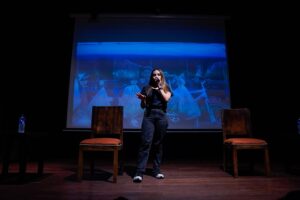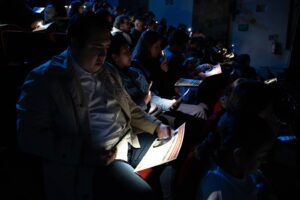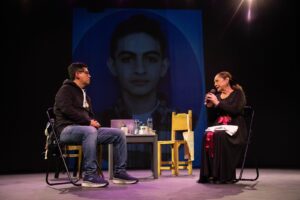Between two chairs, two journalists and a stage, a scene takes shape.
In the dark, between 400 to 500 people take their seats to learn about a palm project that displaced the Sikuani Indigenous people from their ancestral territory for more than 16 years.
But this isn’t like other theatrical productions that normally take to the stage. The basis for this scene is a journalistic investigation by Colombian site Rutas del Conflicto, which specializes in reporting about the armed conflict, and environmental site Mongabay.
“Every time we leave a theater space, people have a much closer look at what is going on in the territory,” Óscar Parra, director of Rutas del Conflicto, told LatAm Journalism Review (LJR).

Pilar Puentes speaks during the Rutas del Conflicto performance on displacement of the Sikuani Indigenous people. (Photo by Ricardo Quintero/Rutas del Conflicto)
The set consists of two wooden chairs, where journalists play their role of engaging an audience for an hour and a half instead of mere minutes – as usually happens in online media. Pages and letters become something alive and visual that builds a connection with the audience, Parra said.
“The difference is the practical way of understanding an investigation,” Juan Carlos Contreras, photojournalist for Rutas del Conflicto, told LJR. “Many times a text is difficult to read, people do not understand it or do not read it completely. There is interaction with the public here.”
In the course of the “stand-up,” as the journalists call the theatrical production, the audience is shown a series of photographs, testimonies from Indigenous peoples and documents. In this way, they understand the reality of the Sikuani, Contreras said.

The audience reads material during a Rutas del Conflicto theatrical performance about the so-called 'false positive' victims in Colombia. (Photo by Nicole Acuna/Rutas del Conflicto)
When a news consumer reads a story online, their time is very short, compared to what happens in the theater. For investigative journalists, it is difficult to find ways to increase eye exposure time on the published text, Parra said.
He said another advantage of standing on stage as a journalist is the type of people in the audience. In another theatrical performance from Rutas del Conflicto, the reporters presented an investigation into the so-called “false positives” of the Colombian armed conflict, civilians who were falsely accused of being guerrilla members and killed by the military. Parra said members of the Constitutional Court were in the audience and even interacted with the information presented after the performance.

Lucero Carmona (right), mother of a victim of the 'false positives' operations in Colombia, speaks alongside Oscar Parra (left) during a theatrical performance by Rutas del Conflicto. (Photo by Nicole Acuna/Rutas del Conflicto)
The investigation for the performance about the palm project highlights a region forgotten by the State, treasured by the Sikuani and coveted by businessmen. Due to Colombia's internal armed conflict, many Indigenous people, not just the Sikuani, find themselves with no choice but to migrate. In the theatrical production, these interests for the use of these ancestral lands are interpreted in dark characters with ties to drug trafficking, taking control of the legal system to invade and exploit the territory for the palm business, María Isabel Torres, program editor for Mongabay Latam, told LJR.
“It is important to show the story with the claims made by the Sikuani community,” Parra said. “It (change) is also more enhanced if we have people in the public who can make decisions.”
Torres said distractions such as the telephone do not intercept the journalistic message in this format. Attentive listening is constant, away from online noise such as misinformation or fake news, which create a disconnect between the user and the content.

Juan Carlos Contreras and Oscar Parra perform as part of Rutas del Conflicto's theatrical production on the displacement of the Sikuani Indigenous people. (Photo by Ricardo Quintero/Rutas del Conflicto)
This theatrical format “allows us journalists to delve deeper into our narrative techniques to tell not only the complaint, but also the stories of our characters and even encourage us to share our own anecdotes while we investigate,” Torres said.
The two elements, the essence of theater and journalistic narrative, create a unique collaborative experience, generating a space where the audience follows the narrative dialogue from the edge of their seats.
"Proposals like those of Rutas del Conflicto are part of this search that many journalists are doing not only to reach more people, but to reach our readers better, with greater connection," Torres said.
*Sara Solano Aguirre is an international student from Colombia and a junior majoring in journalism at the University of Texas at Austin. Moving from Medellin to Pensacola and transferring to Austin, a constant in her journey has been a passion for writing in both English and Spanish to stay connected with her roots and increase Hispanic viewership. She also serves as a Spanish news translator for the Daily Texan, a podcast producer for the Drag and is active in Texas Student Television. Wearing the many hats of journalism has versed her well in the shared language of news, which she strives to hold to the highest standards in every format.